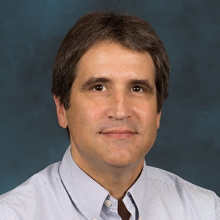-
Title
Physical Chemist -
Email
savina1@llnl.gov -
Phone
(925) 422-0560 -
Organization
Not Available
Professional Background
-
Physical chemist, Lawrence Livermore National Laboratory (2015–present)
Development of Resonance Ionization Mass Spectrometry instruments and methods for nuclear forensics, nuclear astrophysics, and trace isotopic measurements of actinides.
-
Group leader, Argonne National Laboratory (2009–2015)
Directed energy interactions with surfaces group leader.
-
Chemist, Argonne National Laboratory (1998–2015)
Development of resonance ionization mass spectrometry instruments and methods for nuclear astrophysics and nuclear forensics, trace isotopic measurements of actinides, and tunable laser system design. Laser-based decontamination methods for decontamination of nuclear facilities. Fundamental studies of laser damage in high quality optical materials used in the National Ignition Facility.
-
Postdoctoral Research Associate, Argonne National Laboratory (1995–1998)
Development of a microscopic chemical imaging mass spectrometer. Fundamental studies of intense ultrashort laser pulse interactions with gas-phase atoms and molecules, and applications of laser postionization techniques in surface analysis.
-
Senior Research Technologist, Dow Chemical Company, Midland, MI (1981–1989)
Research and development of polyurethane systems for reaction injection molded elastomers, molded and sound-deadening foams, and associated process equipment.
Research Interests
Dr. Savina is a physical chemist in the Nuclear and Chemical Sciences Division at Lawrence Livermore National Laboratory. He is the author of 50 peer-reviewed publications, one book chapter, and four patents. He has developed trace isotopic detection methods for actinides for use in astrophysical and nuclear forensics studies. His trace isotopic analyses of micron–sized stardust grains provide insights into the mechanisms by which elements are created in stars.
PhD, Physical Chemistry, The University of Michigan, 1995
MS, Physical Chemistry, The University of Michigan, 1991
BS, Chemistry, Saginaw Valley State College, 1988
- “Simultaneous Isotopic Analysis of U, Pu, and Am in Spent Nuclear Fuel by Resonance Ionization Mass Spectrometry,” M. R. Savina, B. H. Isselhardt, R. Trappitsch, Analytical Chemistry, 93 (2021) 9505-9512.
- “Resonance ionization mass spectrometry (RIMS): Fundamentals and applications including secondary neutral mass spectrometry,” M. Savina, R. Trappitsch, in: L. Hanley, R. Zimmermann (Eds.), Photoionisation and Photo-induced Processes in Mass Spectrometry, Wiley-VCH Verlag GmbH & Co. KGaA, (2020) pp. 440.
- “Isotopes of Barium as a Chronometer for Supernova Dust Formation,” U. Ott, T. Stephan, P. Hoppe, M. R. Savina, The Astrophysical Journal, 885 (2019) 128.
- “A non-destructive internal nuclear forensic investigation at Argonne: discovery of a Pu planchet from 1948,” J. A. Savina, J. L. Steeb, M. R. Savina, C. J. Mertz, J. A. Fortner, V. S. Sullivan, M. E. Bennett, D. B. Chamberlain, Journal of Radioanalytical and Nuclear Chemistry, (2016) 1-10.
- “New Constraints on the Abundance of 60Fe in the Early Solar System,” R. Trappitsch, P. Boehnke, T. Stephan, M. Telus, M. R. Savina, O. Pardo, A. M. Davis, N. Dauphas, M. J. Pellin, G. R. Huss, The Astrophysical Journal Letters, 857 (2018) L15.
- “Extinct Technetium in Silicon Carbide Stardust Grains: Implications for Stellar Nucleosynthesis,” M. R. Savina, A. M. Davis, C. E. Tripa, M. J. Pellin, R. S. Lewis, S. Amari, R. Gallino, Science, 303 (2004) 649-652.


